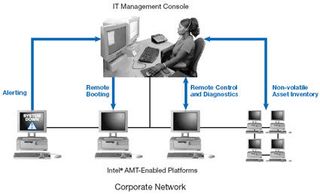Intel's 955X Dual-Core Chipset Better For Business Users Than NVidia's nForce4
Intel Active Management Technology

The acronym iAMT has been in circulation for months, and stands for "Active Management Technology." Behind the term you'll find motherboard firmware extensions designed to make system management more independent of the operating system (another related catchphrase here is Out of Band, or OOB, operation). Of course, this means some kind of side-band or alternate means of system access is required for management access.
Through its ability to query information related to platforms, hardware and software in use on various systems, iAMT enables quick enterprise system inventories. The iAMT architecture also makes the operating state of inventoried machines irrelevant: they can be up and running, or Windows can be inoperable, yet this data can still be retrieved.
iAMT can also play a role in troubleshooting: Because it can report on basic problems and faults, it saves time and cost for service technicians who would otherwise have to inspect machines in person and diagnose problems themselves. Only swapping out a faulty component requires actual human intervention. It's even possible that iAMT could provide early warning of pending failures as well.
Software management, including patch management, and installing new drivers or updates, is something iAMT can handle, thanks to remote control and operation capabilities. iAMT also makes it easier for enterprises to establish proactive security, and deal more effectively with worms and viruses, because it enables them to plan for and to keep firewalls and anti-virus solutions completely up-to-date.
Stay on the Cutting Edge
Join the experts who read Tom's Hardware for the inside track on enthusiast PC tech news — and have for over 25 years. We'll send breaking news and in-depth reviews of CPUs, GPUs, AI, maker hardware and more straight to your inbox.
Current page: Intel Active Management Technology
Prev Page Intel Matrix Storage Technology: Now Includes RAID 5 Next Page Major Competitor: Nvidia nForce4 Intel EditionMost Popular

